马达加斯加西北部恒定频率回声定位蝙蝠的栖息地利用——一个可能的新物种的声学证据
IF 0.7
4区 生物学
Q4 ZOOLOGY
引用次数: 2
摘要
生物声学是研究蝙蝠回声定位的一种非侵入性、成本效益高的方法,尤其适用于检测和识别稀有或隐蔽物种。与岛上其他动物相比,马达加斯加的食虫蝙蝠研究不足,对它们的栖息地用途知之甚少。在这里,我们在马达加斯加西北部萨哈马拉扎-拉达马岛国家公园的蝙蝠调查中使用了远程生物声学测量技术,以研究恒定频率回声定位蝙蝠(Hipposideridae和Rhinoniteridae)。我们使用了两个被动声学监测单元,在该地区特有的一系列栖息地类型中,自动记录蝙蝠从黄昏到黎明的活动。对叫声声学参数的分析揭示了国家公园内三种不同的恒定频率语音类型,我们确定它们是Commerson叶鼻蝙蝠(Macronyteris commercesoni)、红三叉蝙蝠(Triaenos menamena)和一种未知的约78 kHz的语音类型。我们发现这三个物种的栖息地使用存在显著差异,这表明马达加斯加蝙蝠对特定物种的栖息地偏好。我们的统计分析显示,这三种语音类型的声学回声定位呼叫之间存在显著差异。78 kHz的叫声与马达加斯加目前描述的任何其他恒定频率叫声蝙蝠物种都不匹配,这表明蝙蝠亚种群之间的声学差异或可能存在一个新的未描述物种。这些结果突出表明,需要加大调查力度,以了解马达加斯加蝙蝠的物种特定地理分布和栖息地使用情况,并解开其神秘的物种复合体。本文章由计算机程序翻译,如有差异,请以英文原文为准。
Habitat Use of Constant Frequency Echolocating Bats in North-West Madagascar with Acoustic Evidence for a Possible New Species
Bioacoustics can be a non-invasive, cost-effective way of studying echolocating bats, and is especially useful for detecting and identifying rare or cryptic species. The insectivorous bats of Madagascar are understudied in comparison to the rest of the island's fauna, and very little is known about their habitat use. Here, we used a remote bioacoustic surveying technique in a bat survey of the Sahamalaza-Îles Radama National Park, northwest Madagascar, to study constant frequency echolocating bats (Hipposideridae and Rhinonycteridae). We used two passive acoustic monitoring units to automatically record bat activity from dusk until dawn in a range of habitat types that are characteristic of the region. Analysis of call acoustic parameters revealed three distinct constant-frequency phonic types within the national park, which we identified as Commerson's leaf-nosed bat (Macronycteris commersoni), the red trident bat (Triaenops menamena) and an unknown phonic type of ca. 78 kHz. We found significant differences in the habitat usage of these three species, suggesting species-specific habitat preferences among Madagascar's bats. Our statistical analyses revealed significant differences between the acoustic echolocation calls of these three phonic types. The 78 kHz calls do not match any of the other constant frequency-calling bat species currently described for Madagascar, indicating either acoustic divergence among bat sub-populations or the possible existence of a new undescribed species. These results highlight the need for increased survey efforts to gain an understanding of species-specific geographic distributions and habitat usage among Malagasy bats and to disentangle their cryptic species complexes.
求助全文
通过发布文献求助,成功后即可免费获取论文全文。
去求助
来源期刊

Acta Chiropterologica
生物-动物学
CiteScore
2.50
自引率
20.00%
发文量
42
审稿时长
>12 weeks
期刊介绍:
Acta Chiropterologica, published by the Museum and Institute of Zoology at the Polish Academy of Sciences, is devoted solely to the study and discussion of bats.
 求助内容:
求助内容: 应助结果提醒方式:
应助结果提醒方式:


